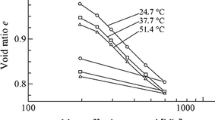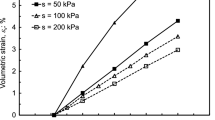Abstract
This study presents a sophisticated elastoplastic constitutive model for unsaturated soil using Bishop-type skeleton stress and degree of saturation as state variables in the framework of critical state soil mechanism. The model is proposed in order to describe the coupled hydromechanical behavior of unsaturated soil irrespective of what kind of the loadings or the drainage conditions may be. At the same time, a water retention characteristic curve considering the influence of deformation on degree of saturation is also proposed. In the model, the superloading and subloading concepts are introduced to consider the influences of overconsolidation and structure on deformation and strength of soils. The proposed model only employs nine parameters, among which five parameters are the same as those used in Cam-Clay model. The other four parameters have the clear physical meanings and can be easily determined by conventional soil tests. The capability and accuracy of the proposed model have been validated carefully through a series of laboratory tests such as isotropic loading tests and triaxial monotonic and cyclic compression tests under different mechanical and hydraulic conditions.













Similar content being viewed by others
References
Alonso EE, Gens A, Josa A (1990) A constitutive model for partially saturated soils. Géotechnique 40(3):405–430
Asaoka A, Nakano M, Noda T (1998) Super loading yield surface concept for the saturated structured soils. In: Proceedings of the 4th European conference on numerical methods in geotechnical engineering-NUMGE98. Udine, 232–242
Callisto L, Rampello S (2004) An interpretation of structural degradation for three natural clays. Can Geotech J 41(3):392–407
Chillarige AV, Morgenstern NR, Robertson PK, Christian HA (1997) Seabed instability due to flow liquefaction in the Fraser River delta. Can Geotech J 34(4):520–533
Chiu CF, Ng CWW (2003) A state-dependent elasto-plastic model for saturated and unsaturated soils. Géotechnique 53(9):809–829
Dafalias YF, Manzari MT (2004) Simple plasticity sand model accounting for fabric change effects. J Eng Mech 130(6):622–634
Gallipoli D, Gens A, Sharma R, Vaunat J (2003) An elastoplastic model for unsaturated soil incorporating the effects of suction and degree of saturation on mechanical behavior. Géotechnique 53(10):41–54
Gallipoli D, Wheeler SJ, Karstunen M (2003) Modelling of variation of degree of saturation in a deformable unsaturated soil. Géotechnique 53(1):123–135
Grozic JLH, Robertson PK, Morgenstern BR (2000) Cyclic liquefaction of loose gassy sand. Can Geotech J 37(4):843–856
Hashiguchi K, Ueno M (1977) Elastoplastic constitutive laws of granular material, Constitutive Equations of Soils. In: Proceedings of the 9th international conference on soil mechanics and foundation engineering. Spec Ses 9, Tokyo, JSSMFE, 73–82
Honda M (2000) Research on the prediction methods for the mechanical behaviors of unsaturated soils. Ph.D. thesis. Kobe University
Hsu JRC, Jeng DS, Lee CP (1995) Oscillatory soil response and liquefaction in an unsaturated layered seabed. Int J Numer Anal Methods Geomech 19(12):825–849
Ishihara K, Tsukamoto Y, Kamada K (2004) Undrained behaviour of near-saturated sand in cyclic and monotonic loading. In: Triantafyllidis T (ed.) Proceedings of the International Conference on Cyclic Behavior of Soils and Liquefaction Phenomena, vol 2. Bochum, pp 27–39
Jennings JEB, Burland JB (1962) Limitations to the use of effective stresses in partly saturated soils. Geotechnique 12(2):125–144
Khalili N, Habte MA, Zargarbashi S (2008) A fully coupled flow deformation model for cyclic analysis of unsaturated soils including hydraulic and mechanical hysteresis. Comput Geotech 35:872–889
Kohgo Y, Nakano M, Miyazaki T (1993) Theoretical aspects of constitutive modelling for unsaturated soils. Soils Found 33(4):49–63
Lloret-Cabot M, Wheeler SJ, Sanchez M (2017) A unified mechanical and retention model for saturated and unsaturated soil behavior. Acta Geotech 12:1–21
Loret B, Khalili N (2002) An effective stress elastic-plastic model for unsaturated porous media. Mech Mater 34(2):97–116
Mroz Z, Norris VA, Zienkiewtcz OC (1978) An anisotropic hardening model for soils and its application to cyclic loading. Int J Numer Anal Meth Geomech 3(2):203–221
Nuth M, Laloui L (2008) Advances in modelling hysteretic water retention curve in deformable soils. Comput Geotech 32:771–801
Ohno S, Kawai K, Tachibana S (2007) Elasto-plastic constitutive model for unsaturated soil applied effective degree of saturation as parameter expressing stiffness. JSCE 63(4):1132–1141 (in Japanese)
Oka F, Kodaka T, Suzuki H, Kim Y, Nishimatsu N, Kimoto S (2010) Experimental study on the behavior of unsaturated compacted silt under triaxial compression. Soil Found 50(1):27–44
Papadimitriou AG, Bouckovalas GD, Dafalias YF (2001) Plasticity model for sand under small and large cyclic strains. J Geotech Geoenviron Eng 127(11):973–983
Qiu XY (2017) Experimental study on the hydro-mechanical behavior of saturated/unsaturated soil and its unified constitutive modeling. Master Dissertation, Nagaya Institute of Technology, Japan (in Japanese)
Sharma R (1998) Mechanical behavior of unsaturated highly expansive soil. Ph.D. thesis. University of Oxford, UK
Sheng D, Zhou AN (2011) Coupling hydraulic with mechanical models for unsaturated soils. Can Geotech J 48(5):826–840
Sheng D, Fredlund DG, Gens A (2008) A new modelling approach for unsaturated soils using independent stress variables. Can Geotech J 45(4):511–534
Song X, Borja RI (2014) Mathematical framework for unsaturated flow in the finite deformation range. Int J Numer Meth Eng 97(9):658–682
Song X, Borja RI (2014) Finite deformation and fluid flow in unsaturated soils with random heterogeneity. Vadose Zone Journal 13(5):1–11. https://doi.org/10.2136/vzj2013.07.0131
Sun DA, Cui HB, Matsuoka H, Sheng D (2007) A three-dimensional elastoplastic model for unsaturated compacted soils with hydraulic hysteresis. Soils Found 47(2):253–264
Sun DA, Sheng DC, Sloan SW (2007) Elastoplastic modeling of hydraulic and stress-strain behavior of unsaturated soils. Mech Mater 39(3):212–221
Sun DA, Sheng D, Xu YF (2007) Collapse behavior of unsaturated compacted soil with different initial densities. Can Geotech J 4:673–686
Sun DA, Sheng DC, Xiang L, Sloan SW (2008) Elastoplastic prediction of hydro-mechanical behavior of unsaturated soils under undrained conditions. Comput Geotech 35(6):845–852
Tsukamoto Y, Kawabe S, Matsumoto J, Hagiwara S (2014) Cyclic resistance of two unsaturated silty sands against soil liquefaction. Soils Found 54(6):1094–1103
Unno T, Kazama M, Uzuoka R, Sento N (2008) Liquefaction of unsaturated sand considering the pore air pressure and volume compressibility of the soil particle skeleton. Soils Found 48(1):87–99
Uzuoka R, Sento N, Kazama M, Unno T (2005) Landslides during the earthquakes on May 26 and July 26, 2003 in Miyagi. Soils Found 45(4):149–163
Wheeler SJ, Sharma RS, Buisson MSR (2003) Coupling of hydraulic hysteresis and stress–strain behaviour in unsaturated soils. Géotechnique 53(1):41–54
Wu W, Bauer E (1994) A simple hypoplastic constitutive model for sand. Int J Numer Anal Meth Geomech 18(12):833–862
Yang C, Cui YJ, Pereira JM, Huang MS (2008) A constitutive model for unsaturated cemented soils under cyclic loading. Comput Geotech 35:853–859
Zhang F, Ikariya T (2011) A new model for unsaturated soil using skeleton stress and degree of saturation as state variables. Soils Found 51(1):67–81
Zhang J, Wang G (2012) Large post-liquefaction deformation of sand, part I: physical mechanism, constitutive description and numerical algorithm. Acta Geotech 7:69–113
Zhang F, Ye B, Noda T, Nakano M, Nakai K (2007) Explanation of cyclic mobility of soils: approach by stress-induced anisotropy. Soils Found 47(4):635–648
Zhou AN, Sheng DC, Sloan SW, Gens A (2012) Interpretation of unsaturated soil behaviour in the stress-saturation space I: volumetric change and water retention behaviour. Comput Geotech 43:178–187
Zhou AN, Sheng DC, Sloan SW, Gens A (2012) Interpretation of unsaturated soil behaviour in the stress-saturation space II: constitutive relationships and validations. Comput Geotech 43:111–123
Acknowledgments
The financial support of the National Nature Science Foundation of China (Grant Nos. 51608385 and 51722812) is greatly appreciated.
Author information
Authors and Affiliations
Corresponding author
Additional information
Publisher's Note
Springer Nature remains neutral with regard to jurisdictional claims in published maps and institutional affiliations.
Appendix moisture characteristics curve [40]
Appendix moisture characteristics curve [40]
In order to properly consider the influence of the degree of saturation on stress–strain–dilatancy relationships of unsaturated soils, a suitable MCC for suction–saturation relation is proposed by Zhang and Ikariya [40]. The MCC includes skeleton curves and scanning curves so that at any moisture state (Sr, s), it is possible to obtain an incremental relation between suction and the degree of saturation as
where ks is the tangential stiffness of suction–saturation relation.
Skeleton curves for the moisture characteristics with tangential and arc-tangential functions are given in three different ways according to the state of the moisture as
-
(1)
Primary drying curve from slurry:
$$ S_{r}^{{}} = S_{r}^{s0} - \frac{2}{\pi }(S_{r}^{s0} - S_{r}^{r} )\tan^{ - 1} ((e^{{c_{1} s}} - 1)/e^{{c_{1} s_{d} }} ) $$(A-2)or
$$ s = \frac{1}{{c_{1} }}\ln \left[ {1 + e^{{c_{1} s_{d} }} \tan \left( {\frac{\pi }{2}\frac{{S_{\text{r}}^{{{\text{s}}0}} - S_{\text{r}}^{{}} }}{{S_{\text{r}}^{{{\text{s}}0}} - S_{\text{r}}^{\text{r}} }}} \right)} \right] $$(A-3) -
(2)
Secondary drying curve experienced drying–wetting process:
$$ S_{\text{r}}^{{}} = S_{\text{r}}^{\text{s}} - \frac{2}{\pi }(S_{\text{r}}^{\text{s}} - S_{\text{r}}^{\text{r}} )\tan^{ - 1} ((e^{{c_{1} s}} - 1)/e^{{c_{1} s_{d} }} ) $$(A-4)or
$$ s = \frac{1}{{c_{1} }}\ln \left[ {1 + e^{{c_{1} s_{d} }} \tan \left( {\frac{\pi }{2}\frac{{S_{\text{r}}^{\text{s}} - S_{\text{r}}^{{}} }}{{S_{\text{r}}^{\text{s}} - S_{\text{r}}^{\text{r}} }}} \right)} \right] $$(A-5) -
(3)
(iii) Wetting curve:
$$ S_{\text{r}}^{{}} = S_{\text{r}}^{\text{s}} - \frac{2}{\pi }(S_{\text{r}}^{\text{s}} - S_{\text{r}}^{\text{r}} )\tan^{ - 1} ((e^{{c_{2} s}} - 1)/e^{{c_{2} s_{w} }} ) $$(A-6)or
$$ s = \frac{1}{{c_{2} }}\ln \left[ {1 + e^{{c_{2} s_{w} }} \tan \left( {\frac{\pi }{2}\frac{{S_{\text{r}}^{\text{s}} - S_{\text{r}}^{{}} }}{{S_{\text{r}}^{\text{s}} - S_{\text{r}}^{\text{r}} }}} \right)} \right] $$(A-7)
where Sd is a parameter corresponding to drying AEV and Sw is a parameter corresponding to WEV, as shown in Fig. 14. c1 and c2 are scaling factors that control the shape of the curves. \( S_{r}^{s0} \) is the degree of saturation of a slurry under fully saturated condition and is equal to 1.0.
As to the scanning curve in the drying–wetting process between the skeleton curves, the incremental relation between suction and saturation is expressed as
\( k_{{{\text{s}}0}} \) is the gradient of suction–saturation relation under the condition that inner variable r equals to 0. \( k_{s1} \) is expressed as:
where c3 is a scaling factor controlling the curvature of the scanning curve. \( k_{s1}^{s} \) is the gradient of the corresponding skeleton curve on which the moisture state (Sr, s) is locating under the condition that r equals to 1, as shown in Fig. 14. According to the illustration shown in Fig. 14, the inner variable r is defined as
Equation (A-8) means that the stiffness of \( k_{s} \) consists of two parts, \( k_{s0} \) and \( k_{s1} \), in a way that its value looks like the value of a spring consisted from two series of springs. It is easily understood from Equations (A-8) and (A-9) that if r = 0, \( k_{s1} \) will be infinite and \( k_{s}^{{}} = k_{s0}^{{}} \). While if r = 1 and \( k_{s0} > > k_{s1}^{s} \), \( k_{s} \) will be equal to \( k_{s1}^{s} \), which coincides with the gradient of the skeleton curve. This explanation can also be easily understood by means of the illustration shown in Fig. 14.
Eight parameters are involved in the proposed moisture characteristics curve, among which three parameters c1, c2 and c3 are determined with curve fitting method, while other five parameters, \( k_{s0} \), \( S_{\text{r}}^{\text{s}} \), \( S_{\text{r}}^{\text{r}} \), Sd and Sw, have definite physical meaning and can be determined by the test of moisture characteristics easily.
In the area between the primary drying curve and the secondary drying curve, the upper bound for the scanning curve is changed from the secondary drying curve to the primary drying curve; and the lower bound for the scanning curve is changed from the wetting curve to a combined curve made from the wetting curve in the region \( S_{{_{r} }} \le S_{r}^{s} \) and the line s = 0 in the region \( S_{{_{r} }} > S_{r}^{s} \). The scanning rule, however, is totally the same as those for the secondary drying–wetting process discussed in Equations (A-8)–(A-10).
Rights and permissions
About this article
Cite this article
Xiong, Yl., Ye, Gl., Xie, Y. et al. A unified constitutive model for unsaturated soil under monotonic and cyclic loading. Acta Geotech. 14, 313–328 (2019). https://doi.org/10.1007/s11440-018-0754-2
Received:
Accepted:
Published:
Issue Date:
DOI: https://doi.org/10.1007/s11440-018-0754-2





